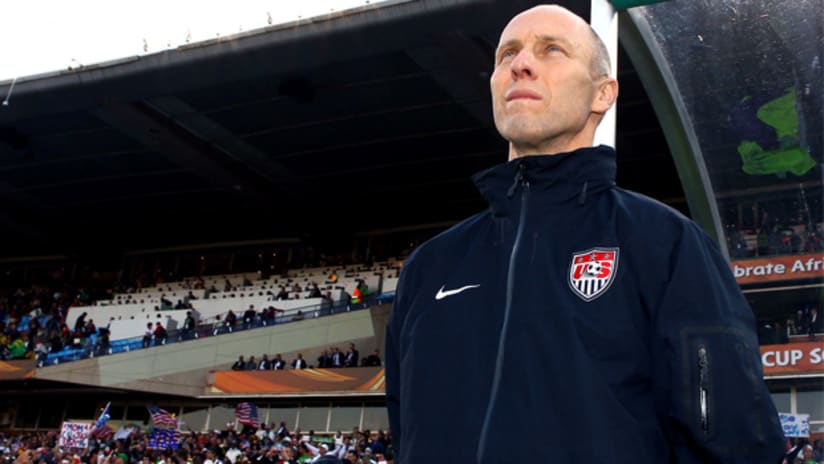US National Team boss Bob Bradley has been signed up for another World Cup cycle, which of course means it's time for another round of entirely unsolicited advice.
Though there is a great big forthcoming slate of activities before that next chance at the big stage, let's look beyond all the qualifying and Gold Cupping to come.
Instead, let's focus on what needs to happen for greater success at that next World Cup in Brazil, which represents both the culmination and crunch time pinnacle of any four-year cycle.
We'll split these suggestions into two sections. First, we will cover some notes should Bradley plan to stick with basically the same 4-4-2 and run the same general tactics. Next time, we'll offer a few game plan alterations to consider.
So, where are the soft spots in Bradley's favored 4-4-2 "empty bucket"?
[inlinenode:311405]Focus!
There are mistakes you can live with and then there are mistakes that make everyone chew down their nails. For a team that is so typically dialed into the game, the USMNT sure do tend to take the odd mind vacation.
The formation and general game plan used by Bradley practically ensures plenty of tight contests. In such games, especially during the World Cup, mistakes are an albatross.
Counting the three tune-up friendlies and the four matches in South Africa, the Nats conceded (with two cases of overlap) twice on set pieces, twice from a deep throw-in, twice on long balls over the top, twice from failing to track a back post run and three times on bad midfield turnover counters. What's more, many of these happened either very early or very late in a period.
One could actually say the US now rarely leak goals without a mistake being made. World Cup flubs get punished quickly, and if Bradley wants to play chess every time out, the number of concentration errors in the team has to decrease.
Spine adjustments
Simply put, there cannot be so much shuffling of the central defenders and midfielders. In four 2010 World Cup games, the US used two different center-back combos and three different central-midfield tandems.
Hammering home the point, during the three tune-up friendlies, there were two different center-back duos and one other midfield pairing used. Stretching the point, those warm-ups saw three different forward pairings, none of which were run out in South Africa.
It's great that Bradley has the touch to alter what happens in the spine areas after the break. Perhaps, since he wants to play games so tightly, it would be best to not need so many adjustments in the middle.
Even better, it would certainly be beneficial to give the combos he will use when the lights are on in the tune-ups. International players already have the deck stacked against them when it comes to continuity, so there's no need to exacerbate this handicap.
[inlinenode:316495]Who's The Man next to Mike?
Being even more specific than the last point, choosing and settling on the partner for central midfielder Michael Bradley is absolutely essential.
The more that player is switched about, the harder it is for anyone working next to him to achieve the proper middle-of-the-park symbiosis. The success of this formation is more dependent on the solidity of this partnership than that of the center backs'.
As Bradley likes to jet forward when the mood suits him, a huge segment of this player's duties will involve closing the gate behind him.
My early guess is this player will be Maurice Edu, and that's fine. Now, run him out with Bradley every chance you get and let them form a midfield bond. The carnage from shuffling this one spot in the lineup is unmistakable.
Spread the minutes wide
It's more than a little painful to watch Clint Dempsey and Landon Donovan get called in for a meaningless friendly against a weak foe, play most of the game and then have to wring hands later because the team isn't confident in the reserve attackers.
Not only does this hinder the ability to change up the formation, it takes away license to slide either of our wing stars into a role closer to goal when one is needed.
Stuart Holden, perhaps the second-best American crosser of the ball, played no part in South Africa aside from a late cameo in the opener. DaMarcus Beasley barely had more time than that.
That pair combined to play 14 minutes at this World Cup, which means no rest for the weary Dempsey and Donovan, and precious little room to tactically maneuver the look of the offense in dire situations.
[inline_node:305997]The Davies Ultimatum
Let's face it: The current Bradley set only really works against top-level competition with Charlie Davies in behind Jozy Altidore to keep opponents honest.
Time and again in South Africa, the US attack-and-pressure valve system was found wanting, one able cog short in transition. Davies' ability to stretch and work the opposing back five or six is even more important than his added finishing ability.
But until Davies is back to his old self, someone must be found that can fill his shoes, at least in the department of being a nuisance. Of course, this player could always be Dempsey or Donovan, but if Bradley wanted to go that way with the chips down, he sure fooled us all at World Cup.
This issue also revisits the one about using friendly minutes more wisely. In those thee tilts, 45 minutes each went to players that didn't make the South Africa trip (Brian Ching and Eddie Johnson), and another 45 went to Dempsey.
If your strike stable is green, there's only one way to rectify the situation. Yes, Bradley was hindered by the Davies injury, but that happened eight months before World Cup. If Altidore is by far your most trusted and experienced forward at the big dance, it's a problem.


